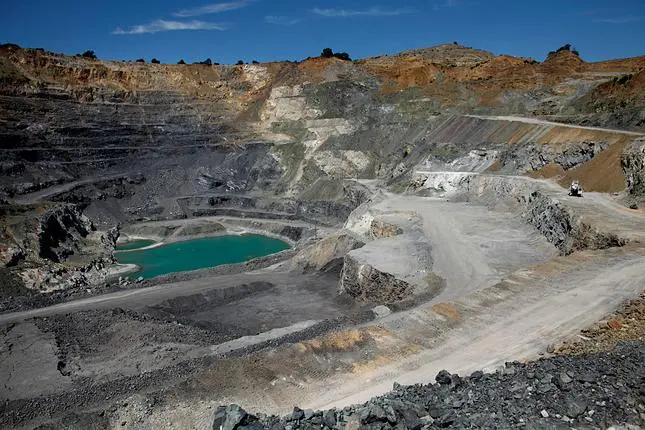Santa Clara County government may buy and shut down Cupertino quarry and cement plant

A major quarry and cement plant in the hills west of Cupertino that have built freeways, dams and buildings across Northern California for generations — but also sparked controversy over pollution and noise — could be purchased and shut down by Santa Clara County, under a plan made public Thursday.
Santa Clara County Supervisor Joe Simitian announced a proposal to require Santa Clara County officials to issue a report in 90 days spelling out options for purchasing the Lehigh Hanson property, including negotiating with its owners or seizing the land by eminent domain.
Calling the quarry “a historical anachronism,” Simitian said at a mid-morning news conference that the site could be better used for open space, with potentially some housing.
“This is an opportunity to respond to the very legitimate concerns of the community, which we’ve been hearing about over the years,” said Simitian, whose district includes the quarry.
“It’s an opportunity to conserve the land,” he said, “in a way that is consistent with the open space values that I think are essential to the place that we are here in Silicon Valley.”
Any public purchase of the property, also known as the Permanente quarry, would likely cost tens of millions of dollars. A forced sale could spark years of legal battles. Simitian said funds could be raised through a parks bond, through housing development proceeds or other methods.
Lehigh Hanson owns 3,510 acres around the quarry, an area three times the size of San Francisco’s Golden Gate Park.
The company, based in Irving, Texas, is owned by Heidelberg Cement, a multi-billion-dollar German company. It is willing to talk, it said Thursday afternoon.
“The Permanente cement plant and quarry have been and remain key contributors to the local economy and vital suppliers to critical Bay Area construction projects,” Lehigh Hanson spokesman Jeff Sieg said in a statement. “As we evaluate optimal reclamation approaches and the future of the property in general, we look forward to hearing the county’s ideas that respect both the community interests and Lehigh’s property rights, as well as help create a more sustainable future.”
The Lehigh plant opened in 1939 and was established by industrialist Henry J. Kaiser. In recent decades, it has produced more than half the cement used in the Bay Area and 70% of the cement used in Santa Clara County.
Its cement built Shasta Dam, Highway 101, Highway 85 and other major Northern California landmarks.
But the facility, whose kilns heat limestone to 2,750 degrees, also has been one of the Bay Area’s largest polluters, ranking at or near the top of Bay Area industrial sites for emissions of greenhouse gases and airborne mercury.
Its current permit requires the large open pit limestone mine to be “reclaimed,” or restored, by 2032. In 2019, the company applied to the county for an extension, seeking to expand the quarry. The county has not granted it, and last February, the company sued the county over the delays.
On Thursday, Simitian noted that other quarry projects have been converted into impressive public facilities.
He cited the Dumbarton Quarry in Fremont, a former gravel pit that was 320 feet deep, and in operation from the 1950s until 2007. The vast hole was filled in and last August opened as a new public campground after years of debate.
Fremont city officials agreed to allow the Dumbarton Quarry to operate 10 years past its permitted 1997 closure date in exchange for the owner, Dumbarton Quarry Associates, designing, constructing and paying for a park and campgrounds at the site. The campground today is run by the East Bay Regional Park District. It has 63 spaces for tents and RVs, picnic areas, a playground, 200-seat amphitheater, restrooms, showers and trails.
Local officials joined Simitian Thursday to endorse the idea of the public acquiring the Cupertino quarry.
“Over the years we’ve had a tremendous amount of truck traffic on a regular basis,” said Cupertino Mayor Darcy Paul. “There are fumes associated with the mines, and when you go to our communities, people wake up in the morning and see a really thick layer of dust on their vehicles. Water quality has been an issue. For us it’s a matter of health.”
Environmentalists endorsed the plan. They said they hope some or all of the property, which abuts the Rancho San Antonio Open Space Preserve, can be acquired for parkland.
“Protecting the open space would have great benefits for wildlife, and for people hiking in appropriate areas,” said Brian Schmidt, legislative advocacy director of Green Foothills, an environmental group in Palo Alto. “Even more dramatically, this is a chance to return hundreds of acres from moonscape conditions to vibrant habitat.”
In recent decades, other Bay Area quarries that once built roads, dams, airport runways and other facilities have closed. Today about a dozen remain in the Bay Area, with cement also coming from others in Redding, Southern California and Canada.
Several labor leaders also supported Simitian’s plan, which will be taken up Tuesday by the Santa Clara County Board of Supervisors. They said the number of union jobs at the Cupertino quarry has dwindled.
“The Teamsters have been running trucks at this plant for 80 years,” said Eddie Venancio, business representative with the Teamsters Local 853. “Our workers also live in the community and look forward to the restoration of the property, which will create good paying jobs for many years.”

